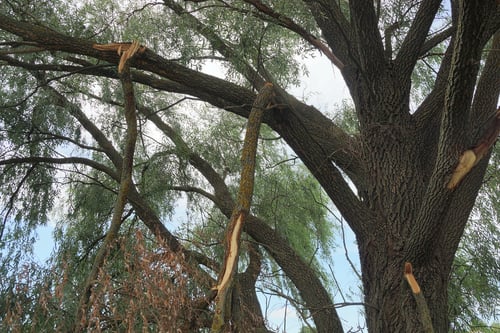It’s almost hiking season in beautiful Colorado. As with any form of recreation, there are inherent risks with hiking that we need to be aware of while we are enjoying time outdoors. It is important to be aware of tree risks and how to protect yourself and stay safe from falling branches. A widow maker is a term used to describe a broken branch that is suspended in the air and stuck on a part of another tree. These branches are extremely dangerous and can fall at any time posing a lethal threat to anyone who might be underneath the tree. The term widow maker has historical roots and refers to the loggers in the forestry industry who have been the victims of these broken branches and tragically passed away, leaving their wives widows. The term is recognized by OSHA and plays a role in the lives of those who work in forestry and any of us who find ourselves surrounded by trees. It is important to be on the lookout for widow makers while hiking, camping and even in your own backyard.

A widow maker is a term used to describe a broken branch that is suspended in the air and stuck on a part of another tree.
Tips for avoiding widow makers while you are recreating in forested areas:
● When hiking in a heavily forested area, scan the canopy above for broken branches and avoid any that you spot.
● Be on the lookout for light-colored wood from the inside of the tree that could highlight a broken branch higher up in the tree.
● Be extremely cautious while hiking and camping around dead trees on super windy days. Large guests, around 40 mph or more, are more likely to knock down widowmakers and dead trees.
● Do not camp directly under tall dead trees.
The easiest time of the year to spot a widowmaker is in the fall or early spring when the deciduous trees have no leaves. This gives a better view of what is going on in the canopy. For coniferous trees, it is harder to spot broken branches so be cautious around them. In your backyard, inspect trees for damaged branches or do a yearly pruning to care for those trees. If you notice a widowmaker in a tree at your own house, it is best to call a professional to remove the branch safely.
As July approaches, the weather can bring strong winds with heavy rain and storms. When the wind picks up, there is a greater risk that a dead tree or branch will fall. Be sure to keep an eye on the forecast and change your plans accordingly. The best time to recreate during the monsoon season is early in the morning as the storms normally roll in around the afternoon. It’s best to be on your way out of the woods when the storms arrive.
While the thought of a widowmaker is very frightening, if you follow the steps above and keep a cautious eye on your surroundings, you can still recreate safely and enjoy your time around trees and in the wonderful forests that surround us here in Eagle County. As always, be sure to follow Leave No Trace principles while out on the trail to ensure the health and longevity of our forests and natural areas. Happy Hiking!
Written by Tori DePauli, a naturalist at Walking Mountains Science Center who loves to spend time hiking and hugging trees no matter what the season.







